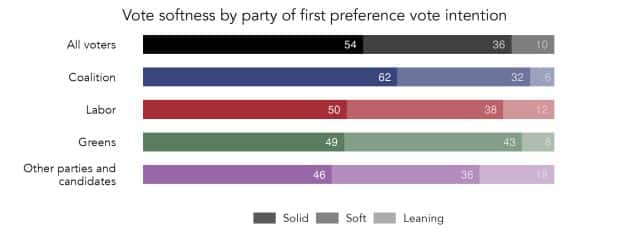The most recent polling following the election campaign launch has Labor leading the Coalition 51% to 49% on a two-party preferred basis. The numbers, provided by Accent Research and Redbridge Group, hide myriad local details and a high proportion of still-undecided voters.
Across all demographic cohorts, roughly a quarter of voters respond “none” when asked which party best aligns with their values. This reflects an overall public mood of financial stress and pessimism.
In a recently released ANU study, one-third of Australians reported being in financial stress. Just 21% of Australians say their life has improved over the past year, and 31% say their situation has worsened. Public confidence in the federal government is at its lowest recorded since January 2020 and the bushfires.
This overall mood of dissatisfaction may be felt more strongly by Albanese than by Dutton. Of Coalition voters, 62% describe themselves as solid, 32% as soft and 6% as leaning. Labor and also the Greens, on the other hand, describe themselves 50% as solid and about 40% as soft and 10% leaning.
In other words, the Coalition voters may be less likely to switch their voters over the coming five weeks. And in this election, a tiny shift one way or the other could turn the outcome.

The minor party share in the 2025 election will be greater than in recent memory. In 2010, just over half of lower-house seats were decided on preferences, but that increased to more than 85% in the 2022 election. In other words, there are very few seats that are straight Liberal-Labor contests anymore.
Interestingly, the Accent poll chose to assess support for “Teal independents” collectively. Kos Samaras of RedBridge justified the decision based on the fact that although they aren’t formally a party, they are a “brand”.
Polling has Melbourne’s two most prominent Teals in tough fights come election day. Zoe Daniel appears to be behind Tim Wilson in Goldstein, while Monique Ryan has just a 51:49 2PP lead in Frydenberg’s old seat of Kooyong.
These seats will be crucial to determining the outcome of the election, as the Teal candidates will also certainly back Albanese for prime minister in a minority government scenario.
On the above numbers, Accent and Redbridge estimate the most likely result being 69 seats to the ALP and 68 to the LNP. This means an Albanese-led minority government remains the most likely outcome.
Sign Up To Our Free Newsletter